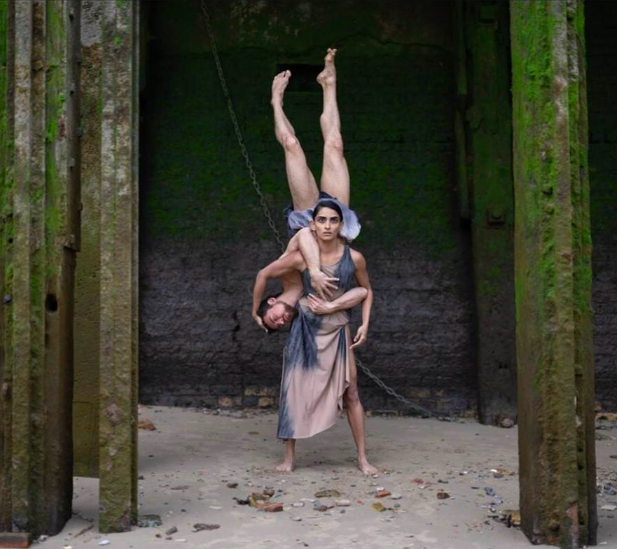Nadī by Aishwarya Raut
Nadī by Aishwarya Raut,
20 September, 2024
Rambert, London
Reviewed by Stacey Prickett
Photo: Deborah Jaffe
Long lengths of cloth bathed in orange and red light soften the angles of the Rambert studio, while the sound of running water evokes a calm evening at sunset. We are taken to another place, its aura enriched by multi-layered sound score and lighting changes that delineate temporary performance spaces. Unintelligible vocalisations are interspersed with whispered phrases that hint at concrete images as attention is drawn to a shadow moving behind fabric hanging from the ceiling. Undulating gestures and a low, grounded squat transforms Aishwarya Raut into other-worldly creatures. As Raut moves out of the shade into the light, Antonello Sangirardi steps into centre stage. He becomes the climbing frame upon which she attaches herself, hanging off his neck and around his back, not passively but using a physical strength that turns into much more emotionally. In Nadī (which means river in Raut’s home language of Marathi), inspiration from nature offers up rich potential to explore shifting relationships. Her choreographic inspiration also engages with resisting societal expectations, paying tribute to strong women and reflecting on folklore from the Konkan region of India. As an emerging choreographer, Raut has a compelling collaborative ethos, and garnered valuable support from The Place, Rambert and the Totally Thames Festival 2024.
The power dynamics and sensuality between the two former Rambert dancers (and partners in life) shape-shift metaphorically as well as bodily. Raut is most often the dominant one, gradually taking on Sangirardi’s weight and initiating movements. A red cloth wrapped around her torso takes on different properties when taken off her body and used to link them to each other. In an evocative section, she places the cloth over both of their heads and ties it to bind them together. It brought to mind René Magritte’s 1928 ‘The Lovers’ painting of a couple pictured in a kiss, their heads covered in cloth. The two also become one in Nadī, as Raut pulls her head off-centre to initiate travel. As they explore the intimacy and possibilities of distance in this bound proximity, the lead changes, the duet’s give and take intensifies as they merge into a multi-limbed organism, ultimately spinning around each other in heightened levels of risk and dependency. In another passage, the cloth is intertwined through their limbs, offering restraint and support as they veer off balance, backbends touch the ground in a cantilever relationship. The cloth also stops the other from pulling away. Once the potential is played out, Raut reties the red cloth around her body, always at the ready. Other dance passages are filled with give and take between the two, unison rhythmic phrases with loping steps move side-to-side, their deep pliés connect to the ground. Expansive floating arm gestures are broken by fractured accents. A slow dance passage stirs images of young love, cradling and moving in sync with each other. Jodi Rabinowitz’s lighting (with associate designer Jake Lawrence) reinforce the mood changes. Dramaturge Aleksander Varadian helped structure the underlying themes of desire, resistance and conformity as set out in the PR material.
Atmospheric variety is built through the instrumental, electronic and vocal sound score by Nordra (a project led by Monika Khot) and composer/musician Dylan Tedaldi. Different rhythms are briefly echoed through body percussion, leading to solo passages that mark out statements of individual strength but also moments of instability in Sangirardi. When they come back together, an intense gaze takes their connection to another level, one not dependent on the physical link of the red cloth. Supportive falls, slow weight shifts signal equality in power and strength. A striking image is of Sangirardi on Raut’s back, his legs reach upward over her head. As she carries him upstage, he shifts to wrap his body around her torso. Lowered to the ground, she sinks down to be with him, this time with an embrace instead of a domineering stance. Nadī is the first part of a longer piece, offering rich promise of more to come.




















